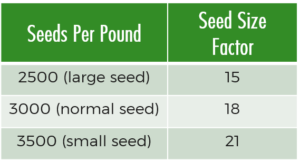As the end of the season draws near we’ve gotten some questions about estimating soybean yields. For some, this is because their crop looks good and they are excited to see what their yields may be, while for others this is because they are prepping themselves for disappointment, as weeks of dry weather have taken a toll on the crop.
Regardless the reason, soybean yield is notoriously difficult to predict. Soybeans have the unique ability to compensate for stresses and there is also a great deal of variability from plant to plant making predictions difficult.
Physiologically, the math seems simple:
Plants/acre x pods/plant x seed/pod x weight/seed
but the numbers for each component are highly variable throughout a field, so when making these estimates I urge you to proceed with caution!
If you do want to make yield estimates, they will likely be more accurate the later in the season you wait. Waiting until the end of R6 or beginning of R7 when flowering has stopped, and pod set is almost complete is best. Just keep in mind, estimates at this time are still variable because environmental stress during the next 4 to 6 weeks can greatly affect pod retention and seed fill.
It is also important to make estimates in different areas of the field to account for within field variability. Depending on soil variability across a field you may need to make 5 to 10 estimates to get a true idea of overall field averages.
Below is a simplified approach to estimating yield that allows you to sample each area quickly, meaning it should be easy to sample multiple areas within the field. The approach is based on 1/10,000th acre and uses the following formula:
Pods in 1/10,000th acre x Seeds/Pod ÷ Seed Size Factor
Step 1: Pods in 1/10,000th acre
You want to estimate the number of pods in 1/10,000th of an acre. To make this easy you just need to remember 21. You will count the number of pods in 21 inches of row length, but the number of rows you count depends on your row spacing. For 30-inch beans, count just 1 row, for 15-inch beans, count 2 rows, and for 7.5-inch beans, count 4 rows.
*Remember to repeat this in different sections of the field and take an average of your counts to get a more accurate estimate
Step 2: Seeds/Pods
Next, we need to determine the number of seeds per pod. If you want a more accurate estimate you could count the number of seeds in 20 to 30 pods to get an average but using an average of 2.5 seed per pod is a good starting point. Since there can be a range of 1-, 2-, 3-, and 4-seed pods, 2.5 is a good conservative estimate.
Step 3: Seed Size Factor
The seed size factor is simply a conversion factor to get from seed/lb to bu/ac. An average bag of 140,000 soybeans is about 50 lb. 140,000/50 = 2800 seed/lb. Assuming seed beans may be a little larger than commodity beans, 3000 seed/lb is a good starting point. In dry years you may want to increase that to 3500 seed/lb (smaller seed mean more seed/lb) or in exceptionally good years you may want to decrease to 2500 seed/lb (bigger seed mean less seed/lb). The following table gives you the seed size factor for various seed sizes. Using a seed size factor of 18 is probably a good estimate for most people.
And that’s it. This “simplified approach” relates the total number of pods in a known area and extrapolates to an acre. Here’s an example assuming 30-inch rows and an average year.
300 pods in 21” of row foot x 2.5 seed/pod ÷ 18 = 41.6 bu/ac
While this approach seems simple and is a good way to ballpark yield numbers, it is by no means error-free. Yield estimates may be fun, but what really matters is what the combine brings in!
Sources:
Casteel, S. 2012. Estimating soybean yields—simplified. Purdue University. https://www.agry.purdue.edu/
Davidson, D. 2018. Estimating soybean yield. ILSoy Advisor. https://www.ilsoyadvisor.com/on-farm/ilsoyadvisor/estimating-soybean-yield









